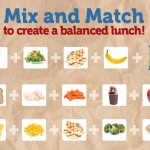
by Sharlee Whiddon | May 24, 2024

No matter your age, good nutrition is key. When we choose to eat healthy, we are making a conscious effort to continually improve our well-being. When we teach young children about the importance of eating healthy, we are helping them to grow, develop, and maintain a healthy lifestyle they will carry on through adulthood. Making these smart food choices, along with regular physical activity, can significantly reduce the risk of developing serious health problems. For individuals who deal with chronic health problems, proper nutrition can aid in the management of their conditions. There are many other benefits that come with eating a healthy diet such as improved mood and mental health, a strengthened immune system, and more sustained energy.
In addition to the benefits of good nutrition, incorporating practical tools such as MyPlate can provide valuable guidance. MyPlate serves as a visual reminder of the types of foods we should be enjoying daily. It simplifies the process of making healthy choices by categorizing foods into five essential groups: fruits, vegetables, grains, protein, and dairy. By incorporating a variety of choices from each group into our daily meals, we make every bite count. Start by making simple adjustments to your daily meals. Whether you are cooking for yourself or your family, take time to plan out meals that include a variety of choices from each food group. If you are preparing for your family, make mealtimes a priority and connect with each other while preparing and enjoying meals together. Turn off the television, put away electronics, and enjoy time together as a family. Have conversations about the colors, texture, and flavor of the food being served.

Children often are more willing to try a food they have grown or prepared.
Photo credit: UF/IFAS photo taken by Camila Guillen.
Growing a garden at home is another fun way to get everyone adding more variety onto their plate. Start with fruits or vegetables that are familiar or even an herb garden that can grow in a kitchen window. Children of all ages will enjoy watching and tending to the garden. This may also inspire children and youth to assist with cooking and food preparation in the kitchen.
Remember, eating healthy is a choice you get to make every day. The importance of good nutrition cannot be overstated, regardless of age. Choosing to eat healthy is a conscious effort that has far-reaching implications for our well-being. By instilling the values of healthy eating in young children, we lay the foundation for a lifetime of positive habits, fostering growth, development, and the maintenance of a healthy lifestyle into adulthood.

by Angela Hinkle | Jun 29, 2016
What’s the best way to enjoy a variety of the nutrients and other substances needed for good health? Eat from every food group every day.
Foods are put into food groups because they provide key nutrients, in about the same amounts. For example, the milk, yogurt, and cheese in the Dairy Group provide about the same amount of the nutrient, calcium. You don’t have to eat from every food group at every meal. However, to get all the nutrients you need for good health, it’s best to eat a variety from each of the five food groups throughout the whole day.
To get that variety, choose different foods within each food group. Oranges are a great source of Vitamin C, but if the only fruit you ever eat is oranges, you’re probably missing out on lots of nutrients in all of those other yummy fruits.![myplate_blue[1]](https://nwdistrict.ifas.ufl.edu/fcs/files/2015/10/myplate_blue1-300x273.jpg)
Fruits like blueberries, apples, and watermelon are high in the nutrients vitamin C, folate, and fiber, which help to maintain the health of your body and decrease some chronic diseases.
Vegetables like kale, squash, and onions offer potassium, fiber, and vitamin A, which can help to maintain healthy blood pressure, lower risk of heart disease, and keep eyes and skin healthy.
Grain Foods, especially the “whole grain” variety like oatmeal, whole wheat bread, and brown rice, are great sources of several B vitamins and minerals – like iron. These and other nutrients in the grains group help the body to release energy, aid in digestion, and form red blood cells.
Dairy foods, like milk, yogurt, and cheese, are excellent sources of calcium, which is important for building and maintaining strong, healthy bones.
Protein foods, including lean meats and poultry, fish, nuts and seeds, eggs, and tofu, provide the protein needed to build, maintain, and repair tissues in our body. Muscles and organs, like your heart, are made of protein.
You don’t have to and probably shouldn’t eat the exact same thing every day. You should, however, Eat Every Food Group Every Day. It’s a brand new day, go ahead…get started…right now!
For more information on ways to get variety in all the food groups, check out this site from the United Sates Department of Agriculture (USDA): http://www.choosemyplate.gov/MyPlate

by Marie Arick | Oct 2, 2015
![myplate_blue[1]](https://nwdistrict.ifas.ufl.edu/fcs/files/2015/10/myplate_blue1-150x150.jpg) The numbers are in and, according to the Centers for Disease Control and Prevention (CDC), 20% or more of the United States adult population is obese in each state. This data was collected during the Behavioral Risk Factor Surveillance System that involves health-related telephone surveys. It has long been discussed in our society that obesity is a growing concern for our population. Many initiatives have been developed to address this issue, such as MyPlate and First Lady Michelle Obama’s Let’s Move! Yet, we still fail to take this to heart.
The numbers are in and, according to the Centers for Disease Control and Prevention (CDC), 20% or more of the United States adult population is obese in each state. This data was collected during the Behavioral Risk Factor Surveillance System that involves health-related telephone surveys. It has long been discussed in our society that obesity is a growing concern for our population. Many initiatives have been developed to address this issue, such as MyPlate and First Lady Michelle Obama’s Let’s Move! Yet, we still fail to take this to heart.
Obesity has been linked to cancer, heart disease, diabetes, and hypertension. All of these can be linked to premature death. And yet, we still pick up those forks and stay off our feet. Even worse, we set a poor example for our children. Many people operate under the assumption that “it does not apply to me,” but it does. The definition of obesity is having a body mass index (BMI) of 30 or higher. The BMI is calculated using your weight in kilograms and dividing this by your height in meters squared. Thankfully, the CDC is one of many sources that has a BMI calculator online to make it simple. The first step is to determine your BMI using one of these calculators, and then to understand what that number represents. The following chart from the CDC explains the results for adults.
The standard weight status categories associated with BMI ranges for adults are shown in the following table:
BMI Weight Status
Below 18.5 Underweight
18.5 – 24.9 Normal or Healthy Weight
25.0 – 29.9 Overweight
30.0 and Above Obese
Next, take this information and act on it. If you have health concerns, see your physician. If you are sedentary, start taking a daily walk or bike ride. Review your personal eating habits and compare it to the MyPlate healthy eating guidelines. MyPlate has online tools that can make meal planning easy and help you track your calories and exercise. Can you make some small changes to improve your dietary intake? Small steps can lead to big changes over time. Modeling these behaviors can not only improve your health and well-being, but the positive changes can impact your children or loved ones as well. Share your goals and seek the support of friends and family. Most importantly, teens and children’s BMI results are interpreted differently. Talk with your child’s physician regarding any weight concerns and dietary guidelines.
Take care of yourself today, set a positive example for those you care about, and put the fork down and get on your feet!

by Ricki McWilliams | Sep 6, 2014
 It’s time to start getting backpacks ready, lunches packed and kids off to school. Back to school time is the perfect time to start packing a healthier lunchbox. Packing your child’s lunch may contribute to the difficulties of getting out the door in the morning but it does not have to. You know your child better than anyone, their likes and dislikes, so go with what you know.
It’s time to start getting backpacks ready, lunches packed and kids off to school. Back to school time is the perfect time to start packing a healthier lunchbox. Packing your child’s lunch may contribute to the difficulties of getting out the door in the morning but it does not have to. You know your child better than anyone, their likes and dislikes, so go with what you know.
The first step to packing a lunch is to determine how much food is enough for your child. You will know you did not pack enough when they come home and tell you they ate all their food and are still hungry. Likewise, if you pack too much, you will know by seeing uneaten or half-eaten items in their lunch box at the end of the day. Start by packing between 3 and 6 items. They will have enough variety in their lunch box to sustain them throughout the school day without too much waste. MyPlate.gov is a great resource for building a balanced meal (protein, vegetable, fruit, grain, dairy).
Secondly, pack as much as you can the night before. This will decrease morning stress. Cut up fruits and vegetables and store in an airtight container in the refrigerator. Cut up fresh ingredients for sandwiches, if required. Make up cracker or dried fruit packs. Wrap up home-baked treats and place in the lunch box.
Lastly, keep in mind this food safety tip: Include gel ice packs to keep refrigerated food cold. Refrigerated food shouldn’t be above 40 degrees for more than 4 hours due to increased bacterial growth causing possible illness.
Lunchbox Meal Ideas:
1.) Wheat crackers, cheese cubes, deli meat, strawberries/blueberries, snap peas (with their favorite dipping sauce*)
2.) Mini quiche, carrots, celery with peanut butter and raisins, whole fruit (pear, orange, banana)
*Want something to dip kid-friendly veggies in besides ranch? Try low-fat Greek yogurt, hummus, or this cottage cheese veggie dip:
1/2 cup low-fat cottage cheese
1/4 teaspoon lemon pepper
Enjoy with baby carrots, snow/snap peas, bell pepper strips
Snack Ideas:
1.) Whole wheat pita cut into wedges with 2 tablespoons hummus for dip
2.) Trail mix: mix 20 almonds, miniature box of raisins, and ¼ cup sunflower seeds
For additional information on creating nutritious meals, contact your local Extension office.





![myplate_blue[1]](https://nwdistrict.ifas.ufl.edu/fcs/files/2015/10/myplate_blue1-300x273.jpg)
![myplate_blue[1]](https://nwdistrict.ifas.ufl.edu/fcs/files/2015/10/myplate_blue1-150x150.jpg)

